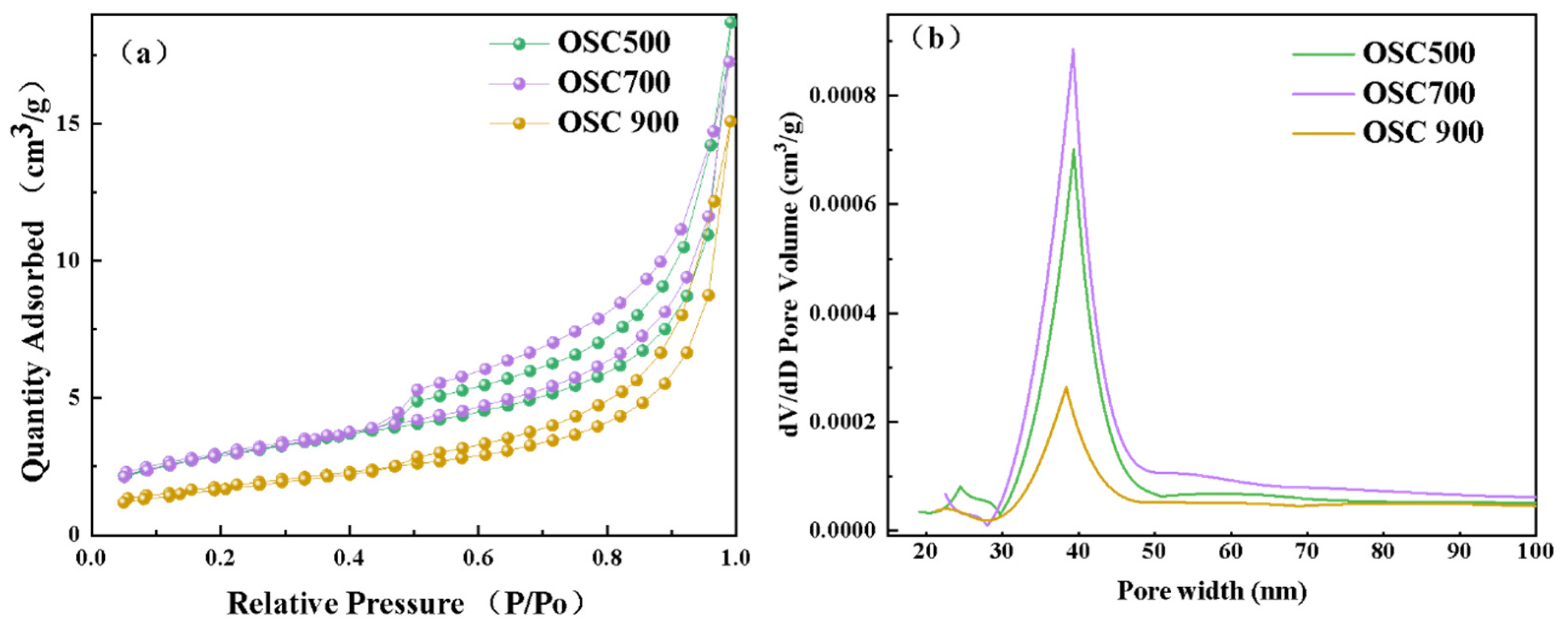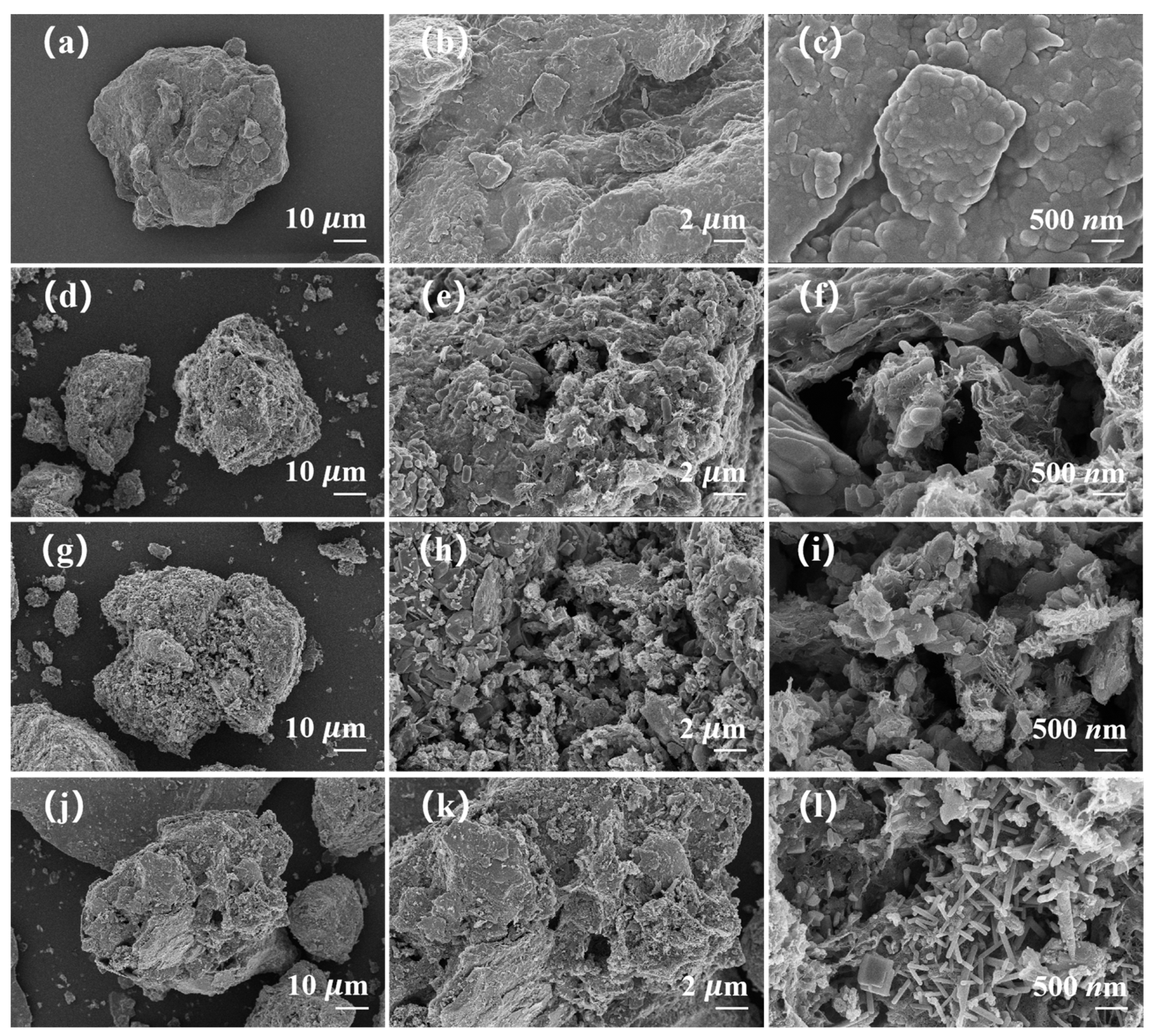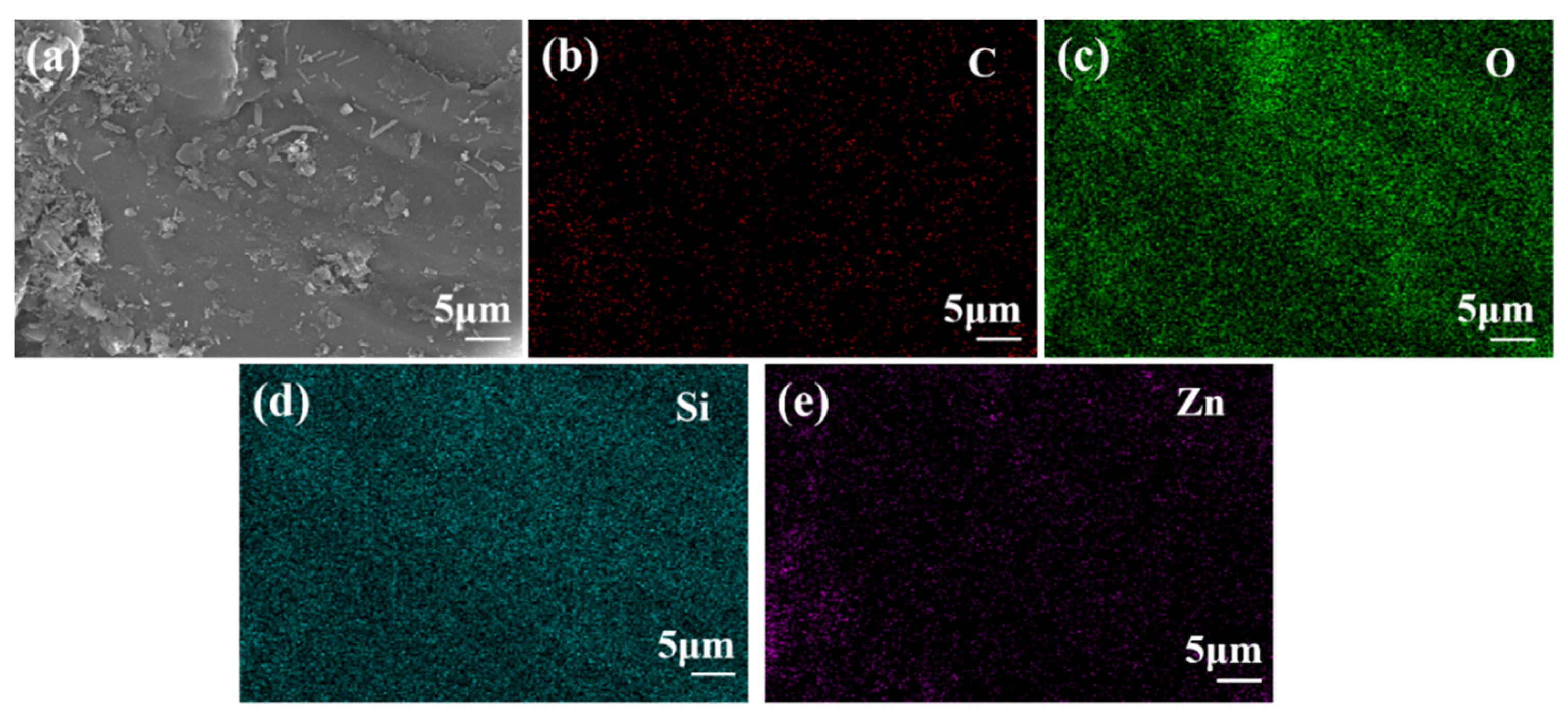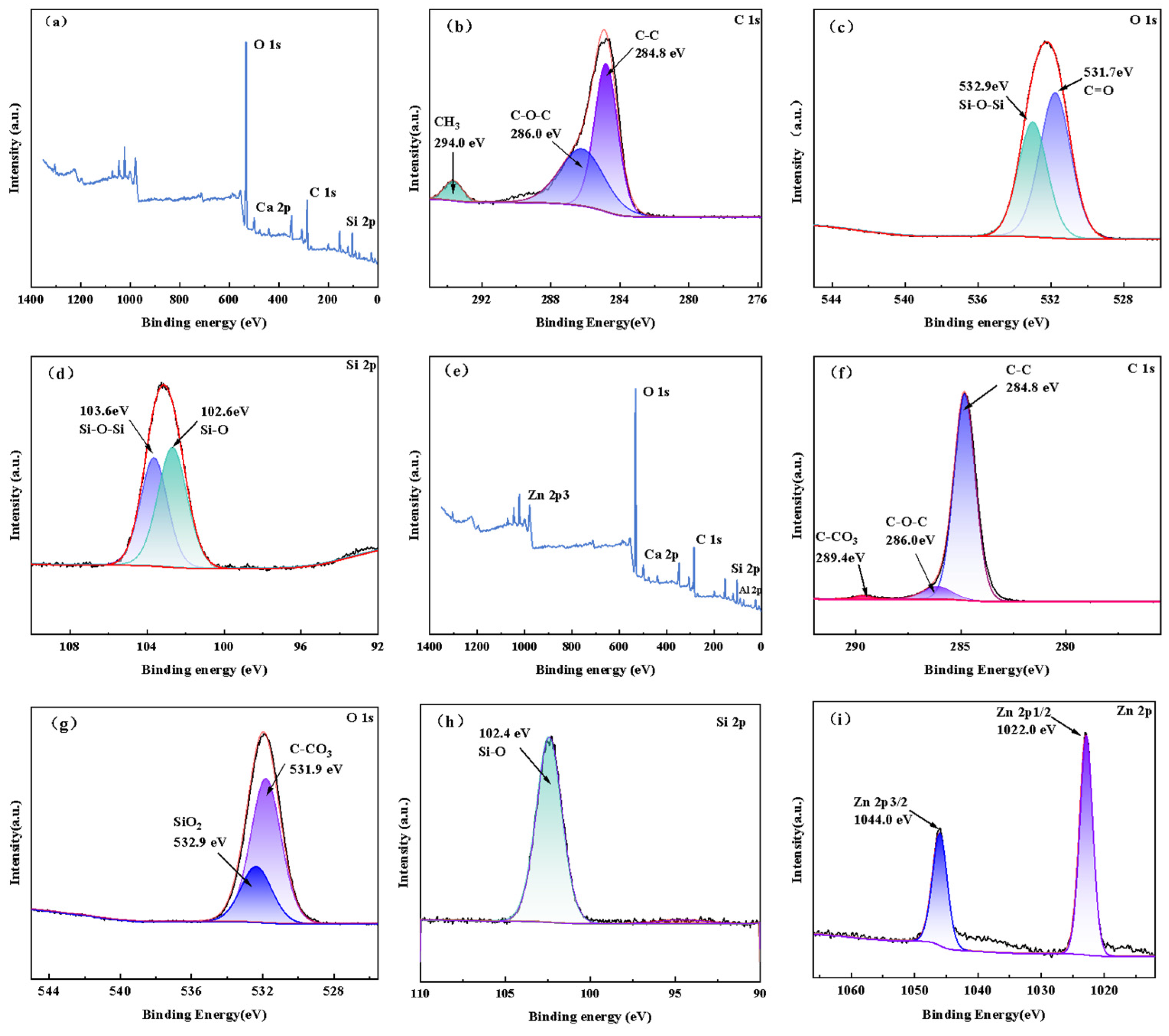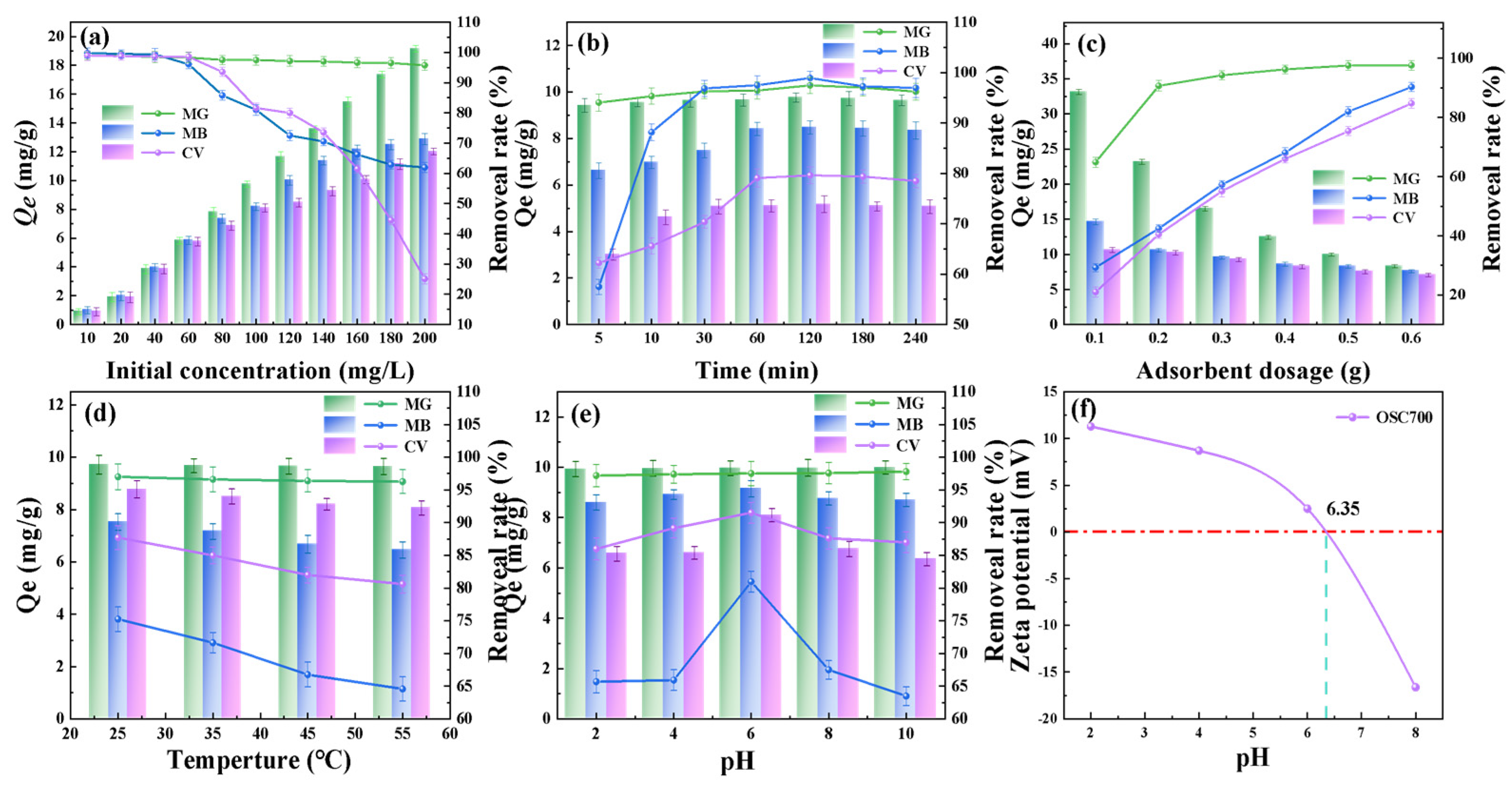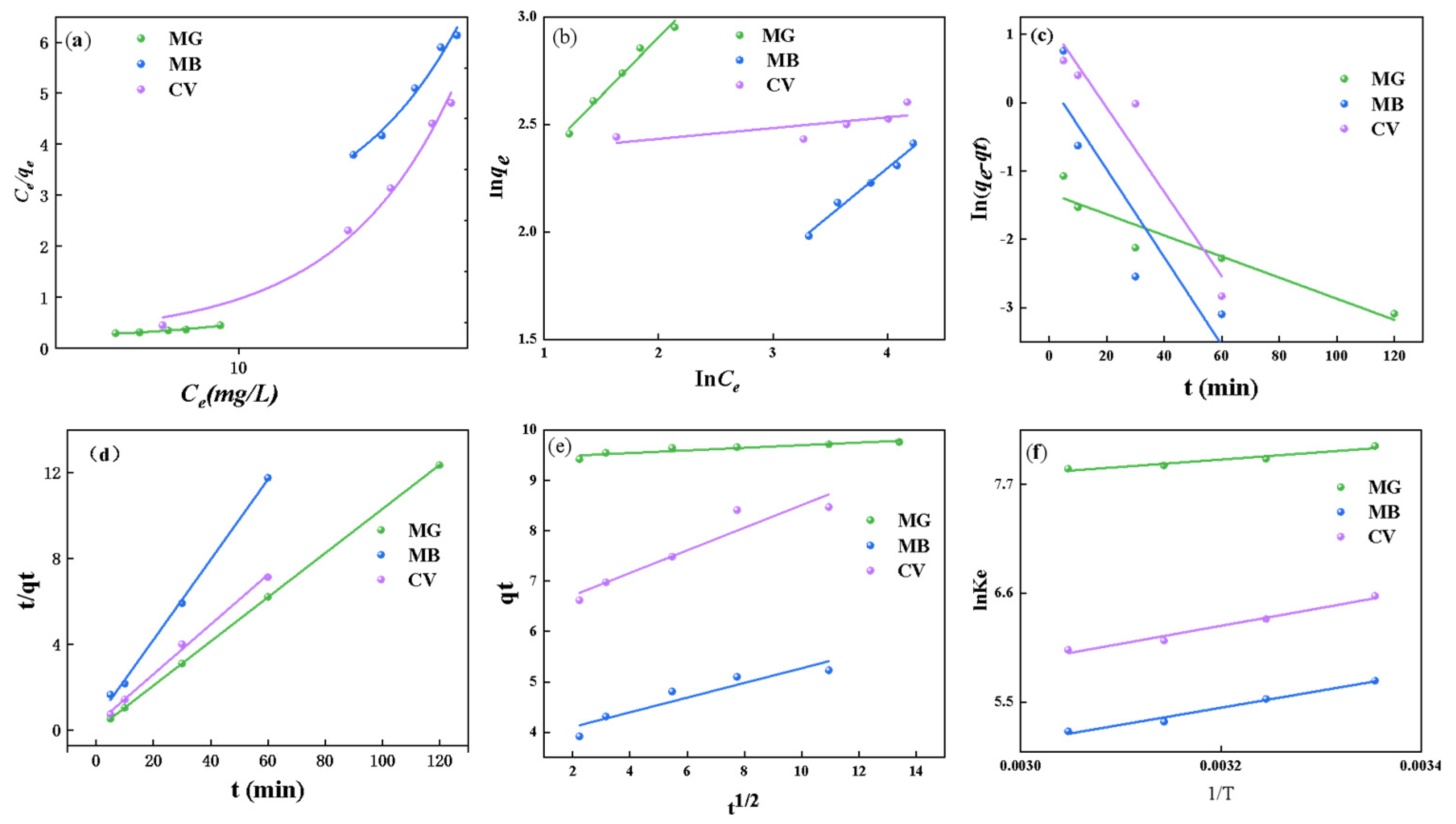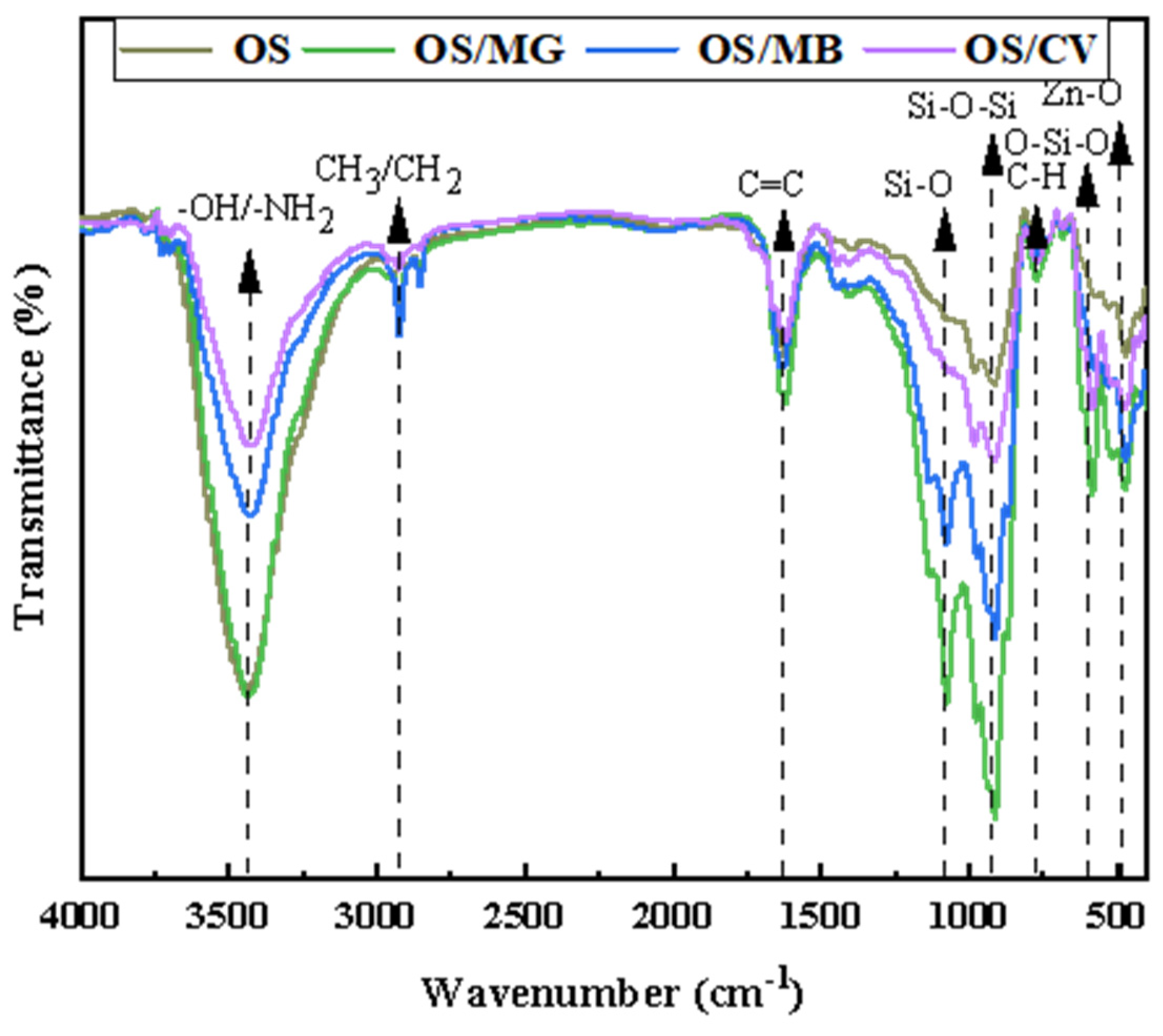1. Introduction
Oily sludge (OS) is a typical solid waste generated in the petroleum processing industry during various stages, including extraction, transportation, storage, and refining [
1]. However, with China’s increasing demand for crude oil, the annual production of oily sludge is projected to exceed 6 million tons by 2024, accounting for an estimated 3.15% of the total output, culminating in a historical inventory of approximately 143 million tons [
2]. Generally, OS contains harmful pollutants such as heavy metals, polycyclic aromatic hydrocarbons, and oily compounds [
3,
4]. The accumulation of OS is not only limiting the development of the petroleum and petrochemical industries but also harmful to the environment [
1,
5]. Dyes in wastewater have become a significant source of water pollution due to the textile, paper, and printing industries [
6]. When released into the environment, organic dyes have various harmful effects on humans and aquatic organisms, and the biodegradation process is slow and complex, releasing possible carcinogenic products [
7]. Therefore, treating and utilizing OS is a key issue for the petroleum processing industry to address.
The commonly employed harmless treatment methods for OS include solvent extraction [
8], ultrasonic irradiation [
9], incineration [
10], stabilization/solidification [
11], and biodegradation [
12,
13]. However, these technologies are limited by large land requirements, high costs, leakage, and air pollution, which hinder their development and adoption. Porous carbon (C) is a promising adsorbent material due to its high specific surface area and abundance of functional groups [
14,
15,
16]. It has been successfully utilized to adsorb various pollutants, including bisphenol A [
17], phenol [
18], Cr-(VI) [
14,
15], Pb(II) [
16], Cd(II) [
19,
20], phosphates [
21], organic dyes [
22,
23], and antibiotics [
24]. Therefore, preparing oily sludge-based porous carbon (OSC) is an effective strategy for harmless treatment and resource utilization of OS.
Compared to expensive activated C and other porous C materials, OSC is a more economical and environmentally friendly option [
25]. However, OS lacks active functional groups, which are essential adsorption sites, thereby limiting the adsorption properties of the as-prepared OSC [
17]. Typically, activating agents such as ZnCl
2, H
3PO
4, and KOH are used to activate C-based materials, enhancing their surface area, porosity, and functional groups [
26]. For instance, Mohammadi et al. [
14] activated OS with KOH, achieving a remarkable 97.36% removal rate for Cd ions. Similarly, Han et al. [
1] synthesized a novel pyrolyzed carbon (PC) by catalytically pyrolyzing OS with phosphoric acid at 411 °C for 59 min. The results demonstrated that the prepared PC exhibited excellent hierarchical porous properties and a high adsorption capacity for methylene blue (MB) of 322.89 mg/g. Similarly, Mojoudi et al. [
18] prepared high-performance activated C with a microporous structure by activating OS with KOH, achieving a BET specific surface area of 2263 m
2·g
−1, total pore volume of 1.37 cm
3·g
−1, micropore volume of 1.004 cm
3·g
−1, and a phenol removal rate of 87.8%. The adsorption process was found to be spontaneous and exothermic. Moreover, ZnCl
2 is widely used as a chemical activator due to its effectiveness in producing a larger specific surface area [
27].
Acharya et al. [
28] examined the adsorption efficiency of ZnCl
2-activated carbon derived from tamarind wood for removing Cr (VI) from water. The study revealed a maximum adsorption capacity of 28.019 mg/g, with the adsorption process being governed by a combination of pore diffusion, film diffusion, and particle diffusion. The results indicated that the adsorption was feasible, spontaneous, and endothermic, suggesting that activated tamarind wood is a viable material for effective Cr (VI) removal from aqueous solutions.
The textile, paper, and printing industries have made dyes in wastewater a significant contributor to water pollution [
6,
29]. When released into the environment, organic dyes can have a range of harmful effects on both human health and aquatic organisms. Moreover, the biodegradation process of these dyes is slow and complex, leading to the release of potential carcinogens. Guo et al. [
30] successfully synthesized a layered MOF, [Cd(H
2L)(BS)
2]n·2nH
2O (L-MOF-1, H
2L = N1,N2-bis(pyridin-3-ylmethyl)ethane-1,2-diamine, BS = benzenesulfonate), which exhibited stability in both acidic and basic environments. Notably, the L-MOF-1 adsorbent demonstrated a remarkable adsorption capacity for CR, reaching approximately 12,000 mg/g within a mere 20 min. Huang et al. [
31] successfully synthesized organobentonite by replacing the exchangeable Na
+ ions in Na-bentonite (Na-Bt) with cetyltrimethylammonium bromide (CTAB). They then conducted a thorough investigation into its adsorption behavior as a highly effective adsorbent for dye removal. The results showed that the maximum adsorption capacities for RhB and Acid Red 1 were 173.5 mg/g and 157.4 mg/g, respectively. These values were achieved at a temperature of 30 °C, with pH levels of 9 and 8, and an initial concentration of 300 mg/L.
David et al. [
32] developed a simple and eco-friendly one-pot method for synthesizing silver nanoparticles, utilizing bioactive components from Viburnum opulus fruit extracts as reducing and stabilizing agents. The researchers then tested the catalytic efficiency of these AgNPs for the degradation of three harmful organic dyes including carmoisine, tartrazine, and vivid blue FCF. All the dyes tested exhibited excellent effectiveness and remarkable catalytic activity in degrading vivid blue FCF. While various adsorbents have demonstrated successful dye removal from water, their practical applications are limited by high raw material costs and complex production processes, which limit their scalability and feasibility.
This study involves the activation of OS using ZnCl2, followed by the preparation of a series of OSC (OSC500, OSC700, and OSC900) through ZnCl2 activation at high temperatures. The phase structures and morphologies of these materials were characterized, and their adsorption properties were investigated for polar dyes. The adsorption models and mechanisms were also proposed. The ultimate goal of this research is to develop a method for designing and optimizing novel adsorbent materials with enhanced selectivity and adsorption capacity.
2. Materials and Methods
2.1. Raw Materials and Preparation of OSC
The OS was obtained from Shengli Oilfield, with a C content of 7.92%. The composition of the OS is shown in
Table 1 and was measured by X-ray Fluorescence Spectrometer. Zinc chloride (ZnCl
2, AR grade) was selected as the activating agent, sourced from Tianjin Kermel Chemical Reagent Co., Ltd., Tianjin, China.
The OS was first dried in an oven at 105 °C for 24 h. Then, the dried OS was ground and sieved through an 80-mesh sieve. Next, the sieved OS and ZnCl2 solution (2 mol/L) were mixed in a 1:1 mass ratio. The resulting mixture was then oscillated in a thermostatic shaker at 30 °C and 150 rad/min for 36 h. Then, the mixture was dried again at 105 °C for 24 h. The as-dried mixture was carbonized in a tubular furnace under a N2 atmosphere. The carbonization temperatures were 500 °C, 700 °C, and 900 °C, with a 2 h hold at each temperature. Finally, the as-carbonized samples were washed with secondary deionized water to remove any residual ZnCl2 and impurities, and then dried at 105 °C for 24 h to obtain OSC samples, designated as OSC500, OSC700, and OSC900, corresponding to their respective carbonization temperatures. Samples activated at 700 °C only, without the addition of a zinc chloride activator, are called NOSC.
2.2. Characterization Methods of OSC
A thermogravimetric analyzer (Netzsch, Selb, Germany) was used to determine the mass loss curve of the samples over a temperature range of room temperature (RT) to 1000 °C. The crystal structures of the OSC samples were investigated using X-ray diffractometer (BRUKER, Berlin, Germany) equipped with Cu Kα radiation. The XRD data were collected in continuous scan mode, scanning from 10° to 90° at a rate of 2°/min. Functional group information of the OSC samples was obtained using a Fourier transform infrared spectrometer (Thermo Scientific Nicolet, Waltham, MA, USA), employing the KBr pellet method. The FTIR spectra were collected at a resolution of 4 cm−1, spanning a range of 400 to 4000 cm−1. The morphologies of the as-prepared samples were examined using scanning electron microscopy (Carl Zeiss, Oberkochen, Germany). The surface elemental composition and ionic states of OSC were determined using X-ray photoelectron spectroscopy (Thermo Scientific Nicolet, Waltham, MA, USA). The adsorption/desorption isotherms of OSC were performed using a nitrogen adsorption/desorption isotherm tester (Micromeritics, Norcross, GA, USA). The adsorbed gas was N2, which was degassed at 120 °C for 7 h. The correlation between the Zeta potential of OSC and the migration rate was determined using a Zeta potential analyzer (Malvern Instruments Ltd., Malvern, UK). The adsorption properties of OSC were characterized using a UV-vis spectrophotometer (Shanghai Youke Instrumentation Co., Shanghai, China), with a scanning wavelength range of 190–1100 nm and an absorbance range of 0.0–3.0 Abs.
2.3. Batch Adsorption Experiment
The effects of adsorbent dosage, adsorption time, adsorption temperature, and pH on the adsorption performance of the coal materials were further investigated in this study through batch adsorption experiments. Specifically, different adsorbent dosages, adsorption temperatures, Malachite Green (MG), Methylene Blue (MB), and Crystal Violet (CV) concentrations, and reaction pH were set in this study, ranging from 0.1 to 0.6 g, 5 to 240 min, 25 to 55 °C, 10 to 200 mg/L, and 2 to 10, respectively. Specifically, the adsorbents were added to 50 mL of MG, MB, and CV standard solutions (100 mg/L) in 100 mL brown conical flasks at the different dosages. The mixtures were then thoroughly stirred using a constant temperature shaking incubator at 150 rpm and 25 °C for 120 min. Afterward, the mixtures were filtered using a 0.45 µm syringe filter. The absorbance values of MG, MB, and CV in the supernatants were determined using a UV-vis spectrophotometer (Shanghai Youke Instrumentation Co., Shanghai, China) at wavelengths of 617 nm, 665 nm, and 554 nm. The MG, MB, and CV concentrations in the solutions were calculated using MG, MB, and CV standard curve equations. These measurements were used to determine the removal and adsorption efficiencies. The collected data were plotted and used for further analysis.
2.4. Calculation of the Dipole Moments for Organic Dyes of Different Polarities
Dipole moment is an important attribute of a molecule, reflecting the extent of its polarity. The larger the dipole moment, the greater the polarity of the molecule. Using the Gaussian 09 program, the B3LYP/6-311g* method is applied to optimize the geometric structures of malachite green, crystal violet, and methylene blue molecules. Furthermore, the Multiwfn 3.3.7 program is utilized to calculate ADCH charges and bond dipole moments, as shown in Equation (1).
The bond dipole moment is a vector quantity, with its direction going from the center of positive charge to the center of negative charge along the direction of the bond. The basic formula can be applied to the situation of charges on multiple atoms. In the Hirshfeld method [
33], the formula for calculating the molecular dipole moment can be expressed as (2).
The general formula for calculating dipole moments is: the dipole moments calculated using Hirshfeld charges tend to be less than the actual situation. According to the method proposed by Lu and Chen [
34], a correction is applied through atomic dipole moments. Therefore, the final method employed is based on the Hirshfeld population (ADCH) method formula, as shown in Equations (3) and (4).
where,
represents the atomic charge, and
denotes the bond length;
is the dipole moment of atom A;
represents the Hirshfeld charge;
corresponds to the vector radius;
refers to the correction charge generated by the dipole moment of atom A on atom B. The ADCH charge takes into account the atomic dipole moments, providing a good reproduction and correction for the calculated dipole moments of molecules [
35].
2.5. Modeling of the Adsorption Isotherms
The removal efficiency (η) and equilibrium capacity (
qe, mg/g) of the three organic dyes were calculated using Equations (5) and (6). The adsorption kinetics were simulated using Equation (7) through (9); the adsorption isotherm model was simulated using Equations (10) and (11); the constant separation factor was calculated using Equation (12) and the separation factor was calculated using Equation (13); Thermodynamic modeling was carried out using Equation (14) to (15) [
36,
37]:
where
C0 and
Ce (mg/L) denote the initial and equilibrium Pb
2+ concentrations, respectively;
V (L) denotes the solution volume;
m (g) is the adsorbent dose;
qt (mg/g) denotes the adsorbed Pb
2+ amount by the CG, CGPC, and PAC-CGPC materials at time t (h); k
1 (h
−1) and
k2 [g/(mg·h)] are the rate constants of the PFO and PSO models, respectively;
qm (mg/g) denotes the maximum adsorption capacity;
KL (L/mg) is the Langmuir isotherm constant;
KF [(mg/g)(mg/L)
n] is the Freundlich adsorption affinity coefficient; 1/
n denotes the adsorption intensity of the Freundlich isotherm. 1/
n < 0, 0 < 1/
n < 1, 1/
n > 1 indicate irreversible, favorable, and unfavorable adsorption, respectively;
R (8.314 J·mol
−1·K) is the ideal gas constant;
T (K) denotes the absolute temperature;
K is the adsorption partition coefficient.
5. Conclusions
In this study, low-oil-content sludge served as the starting material, and ZnCl2 was employed as the activating agent. The OSC was prepared through the thermal decomposition of light and heavy organic constituents in the oily sludge at elevated temperatures, followed by carbon deposition processes.
The as-prepared OSC was thoroughly characterized, and its absorption properties were investigated. The results revealed that the C network framework can be effectively formed in OS by using ZnCl2 as an activator and carbonizing at 700 °C for 1 h. The theoretical monolayer saturation adsorption capacities of OSC700 for MG, MB, and CV were determined to be 33.41 mg/g, 16.41 mg/g, and 13.56 mg/g, respectively. Under optimal adsorption conditions, the removal efficiencies achieved were 95.74%, 64.97% and 24.14%, respectively. The adsorption of MG, MB, and CV by OSC700 was found to follow the pseudo-second-order kinetic model, suggesting a combined mechanism of physical and chemical adsorption, with chemical adsorption being the predominant mode. The adsorption process was spontaneous, exothermic, and entropy-increasing. Quantum functional theory calculations revealed that the dipole moments of MG, MB, and CV follow the polarity order of MG < MB < CV. Notably, the adsorption of MG, MB, and CV by OSC700 showed an inverse correlation between polarity and adsorption performance, with weaker polarity leading to better adsorption effects and higher theoretical and actual saturation adsorption capacities in oily sludge-based porous carbon. The adsorption of low-polarity materials by porous carbon derived from oily sludge is primarily driven by the presence of aromatic functional groups, hydrophily, π-π EDA interactions, and the formation of hydrogen bonds on the surface of the porous carbon. For dyes with higher polarity, electrostatic interactions and hydrophobic effects play a dominant role, with electrostatic adsorption being the primary adsorption mechanism. Notably, the formation of hydrogen bonds is negligible during the adsorption process. In summary, this study provides an effective approach and theoretical guidance for the removal of organic dyes, particularly those with lower polarity, from wastewater, providing valuable insights for the development of efficient wastewater treatment strategies.

